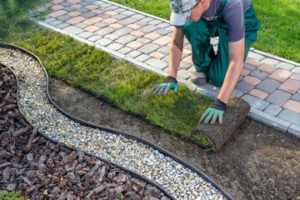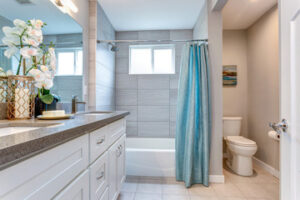Plumbers install and repair piping systems for water supply, heating, sewage, and draining in residential, commercial, and industrial settings. They also inspect plumbing fixtures, ensuring they meet safety and building codes.

To become a plumber, you need to have physical stamina and strong problem-solving skills. You can start by completing a certificate program at a trade school or through an apprenticeship, which lasts a few years and combines in-class training with on-the-job experience. Read on Plumbers Near Me Prices for more information.
Plumbers are responsible for a variety of tasks including installation, maintenance, repair and testing of plumbing equipment. They use their skills to diagnose and fix problems in the home and work closely with electricians, construction workers and other professionals on large building projects. They must also be able to read and interpret blueprints. Depending on the type of plumbing job, they may be required to perform regular inspections and preventive maintenance, or respond to emergency calls.
The most common job duties of a plumber include installing, maintaining and repairing pipes, fixtures and appliances such as bathtubs, showers, toilets and sinks. Other responsibilities include reading and interpreting blueprints, selecting the best materials for each project and providing customers with accurate time and cost estimates.
Many plumbers are self-employed, which allows them to set their own hours and choose their clients. Others work for plumbing companies or government agencies. While these positions offer stability, they do not provide the same level of flexibility or income potential as independent contractor work.
Plumbers must also comply with a variety of legal regulations and licensing requirements, which can vary from state to state. This can make it challenging to maintain a work-life balance and may require them to travel between jobs. In addition, the work can be physically demanding and requires the ability to lift heavy objects and work in tight spaces.
A career as a plumber can be very rewarding for those who enjoy working with their hands and solving practical problems. The work directly impacts people’s lives and provides a sense of accomplishment for those who complete it successfully. Plumbers can also choose to specialize in a certain type of work or project, which may increase their earning potential. For example, some plumbers specialize in kitchen and bathroom renovations, while others may focus on new construction or commercial projects. Still, others choose to focus on emergency services, such as repairing burst pipes and flooding basements. These specialties can be extremely challenging and require additional training and certifications. As a result, it is important for plumbers to be passionate about their work and willing to pursue continuing education and career advancement opportunities.
Education and Training Requirements
If you want to become a plumber, you’ll need a high school diploma or equivalent. This will give you a good foundation to build upon in your career. You can also enroll in a vocational program at a trade school, which offers both classroom education and practical skills training. Some programs also offer apprenticeships that allow you to work under experienced plumbers while earning a wage and learning the trade. Apprentices typically have to pass exams and complete a certain number of years of on-the-job training before they can apply for their journeyman plumber license. You can also choose to become a plumbing apprentice through a union, which will provide you with additional benefits like health insurance and sick leave.
Most states require plumbers to be licensed. The requirements vary by state, but typically include passing a written exam and passing a hands-on test. The exam will test your knowledge of the codes, practices, and theory of plumbing. You’ll also need to learn how to read and interpret blueprints and the different types of pipes and fixtures used in a plumbing system.
You should also take continuing education courses to keep your license valid. New methods for completing projects are constantly developing in the plumbing industry, so it’s important to keep up with changes in technology and regulations. You can find these courses online, at workshops, and through professional organizations. You can also speak with local plumbers who have already gone through the licensing process to see how they prepared for the tests and the licensure exam.
You’ll also need to obtain the appropriate tools and equipment for the job. This includes basic hand and power tools, as well as specialized ones for pipe cutting and fitting, soldering, bending, and threading. You’ll need to know how to use and maintain these tools, as well as the proper safety protocols. You’ll also need to be familiar with the different materials and products used in a plumbing system, including PVC, CPVC, copper, cast iron, and PEX. You’ll need to have excellent problem-solving and technical abilities to be able to diagnose issues and repair them efficiently.
Work Environment
Plumbers can work in a variety of environments. In residential settings, they often work on remodeling and new installation projects. This can include laying out piping systems, connecting appliances and fixtures, and ensuring the plumbing system meets all building codes and specifications. Residential plumbers also perform a significant amount of maintenance and repair work on existing systems. This can include addressing leaks, clogs, and other issues that arise with pipes and fixtures.
Plumbers working on new construction projects may spend time collaborating with architects, builders, and other construction professionals to ensure plumbing is integrated into building plans seamlessly. They also read blueprints and other construction documents to plan out piping systems and install plumbing fixtures and appliances.
Industrial plumbers work with larger, more complex piping systems and equipment found in manufacturing plants and power plants. They are responsible for installing and maintaining large-scale piping systems, boilers, and cooling systems. These plumbers are also needed to assist with emergency maintenance and repairs, as well.
Plumbing technicians work in support roles for plumbers, assisting them with installation and maintenance tasks. They also respond to service calls from customers to address issues like leaks and clogs. Plumbing technicians need strong technical skills and customer service abilities to effectively communicate with clients.
Many plumbers must travel to various work sites each day, so they must be comfortable working in a variety of different environments. This can include tight spaces and cramped areas, as well as outdoor work in bad weather. Plumbers must also be prepared for the possibility of dangerous chemicals or other materials being in their work area, so they should always take caution and follow all safety guidelines. It is also important for plumbers to have good ventilation when working in tight spaces or with hazardous materials, as this can help reduce exposure to dangerous fumes. In addition, plumbers should always wear appropriate protective gear when necessary.
Salary
Choosing the right career path is crucial at any age. You want to pick something that offers a good salary, a steady income, and opportunities for growth and development. One trade that is often overlooked in this search for a perfect career is the field of plumbing. While it may not be the most glamorous or high-profile choice, plumbing is still a viable and well-paying option for anyone with the courage to pursue it.
One of the best things about becoming a plumber is that you don’t need a four-year college degree to get started. Once you have a high school diploma or equivalent, you can take plumbing classes at a technical college to learn how to use piping equipment and become certified in drainage systems. Alternatively, you can apply for a plumbing apprenticeship to learn on the job. While this is more time-consuming than taking plumbing classes, it also gives you the opportunity to start earning money early on in your career without having to worry about student loans.
Once you’re a licensed plumber, you can begin charging for your services. The rate that you charge will depend on your level of experience and the demand for plumbers in your area. You can earn even more by taking additional training and becoming certified in various plumbing techniques. Additionally, you can increase your salary by working for a larger plumbing company, as they will have the resources to pay you higher rates than smaller businesses.
Another thing to keep in mind when deciding on a salary for a plumber is that your taxes and costs of living will have an impact on how much you’re able to make. For example, if you work in an expensive city or region, your wages will be lower than if you worked somewhere with a more affordable cost of living. Additionally, if you’re an independent plumber, you will have to cover your own insurance expenses. All of these factors will have a direct impact on your take-home pay. In summary, the average plumber salary is around $65,190 per year.


